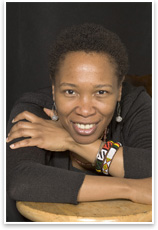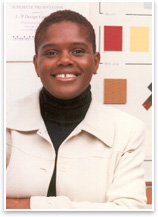
| diversiTY Young African American Women Architects Sharpen Ties to Their Communities Summary: At work is a new generation of minority architects who experience, but are not deterred by the more subtle forms of exclusion and unequal opportunities that persist today. Below is an excerpt of interviews with two such architects: June Grant in Oakland and Zevilla Jackson Preston in Harlem. Their focus is to contribute to society by re-examining current processes, looking at other disciplines for insights, using the latest tools for communicating and delivering design, and becoming a force in the community. (For the full article, click on the PDF link in the reference column.)
SAK: You have two business-related degrees, and a graduate degree in architecture. Why architecture? SAK: Did you at Yale encounter stereotyped attitudes regarding women students and other minorities? SAK: Your firm is called Blink!
SAK: How did you end up starting your own firm? I was fortunate enough to find a firm like Roberta Washington. If I stand on anyone’s shoulders, it’s the Roberta Washingtons of this world! Being a firm owner, I understand that it takes a special principal and a special firm to invest in the development of a young person by taking time to teach a young architect what they themselves had learned from someone else, and not being so busy they’re not willing to pass it on. SAK: What are your design principles? There must be a market for experimental apartment buildings that have nuclear apartment units, along with common kitchens and common dining rooms and common living rooms, and the extended family can rent it. The apartment building then begins to look like a dormitory facility that you might get on a college campus. What’s wrong with that? And as for housing for the elderly, perhaps you don’t really need it. Maybe what you need are extended living environments where you can live with your family in an apartment building and have a separate smaller efficiency unit for an elderly person who’s part of their unit. Why do we have to shut off elderly people in separate buildings? Try telling these things to HPD [Department of Housing Preservation and Development, a New York City agency]. |
||
Copyright 2007 The American Institute of Architects. All rights reserved. Home Page |
||
news headlines
practice
business
design
recent related
› Making Partner in the Majority-Owned Practice
› Three Contemporary Star Architects
› The Trailblazers
To read the full-text PDF version of this article, click here.
Did you know . . .
Missing. The Museum for African Art, whose president is Elsie McCabe, an African American, has awarded the plum commission for its new building to Robert A. M. Stern, FAIA. The choice was largely praised by the majority press, which ignored, however, the deeper implication of withholding the commission from any one of a group of African-American architects who have consistently shown they are able to handle large projects and provide inspiring designs.
The decision, I believe, is a callous slap in the face to architects of color, who one would think had a special affinity for capturing the cultural and design nuances that such a project demands. That does not mean that an architect who is not Black could not handle the project, and Stern is a designer of great talent. Jewish architects have designed Christian churches, and Christian architects have designed synagogues. But withholding this unique opportunity is a sad reflection on how far we still have to go in the advancement of African-American architects in our society.—SAK
Arthur Ashe’s legacy to architects. Jeanne Moutoussamy-Ashe, Arthur’s widow, has done all architects of color a service by issuing a Web site commemorating her late husband’s contributions to Black self-confidence. Jeanne, the daughter of the late celebrated Chicago architect John Moutoussamy, an early partner of color in a white-owned firm who designed the headquarters in the Loop for Johnson Publishing, publishers of Ebony magazine, once told this reporter that Ashe never saw himself as a role model. Instead, he advocated self-confidence and perseverance. Using the metaphor of tennis, he once said: “There are lessons that one can learn out there all by yourself on the tennis court. There are no substitutions, no time outs, and no coaches. You have really to learn to depend upon yourself, you have to learn to become self-sufficient. You have to learn how to make instantaneous decisions that are going to affect the result of the rest of that match. Life is like that.” Amen. Check out the site: www.arthurashe.org. –SAK
Coming next month: “African American Educators, profiles of prominent players on the stage of architectural education.”

 June Grant, RA
June Grant, RA Zevilla Jackson Preston
Zevilla Jackson Preston